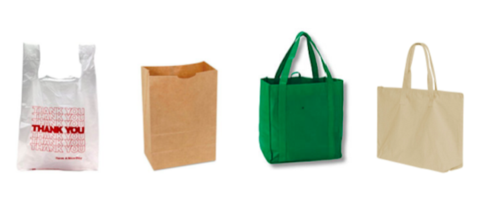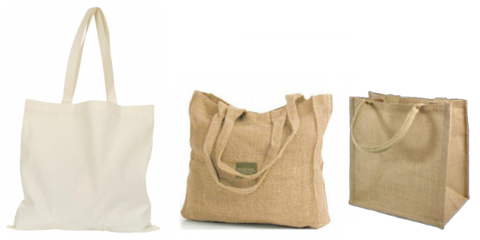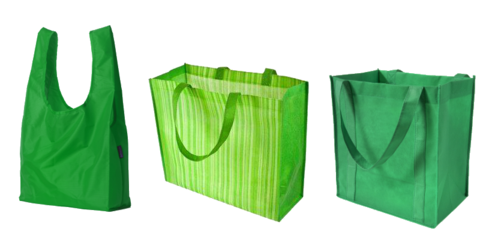Are reusable grocery bags good or bad for the environment?
For every news article that tells us ‘Reusable bags are better for the environment’ there seems to be another one saying ‘Reusable bags are not really eco-friendly’.
The arguments for and against the environmental sustainability of reusable shopping bags can be confusing, so what’s the truth?

WHY DO WE NEED REUSABLE BAGS?
Our ever-increasing use of disposable plastic bags is causing problems around the world, including environmental damage, climate change and pollution, damage to wildlife and natural habitats, and harm to human health.
Reusable bags can help solve these problems by reducing the number of single-use plastic bags manufactured and discarded every day.
WHAT IMPACT DO REUSABLE GROCERY BAGS HAVE ON THE ENVIRONMENT?
There is a wide range of reusable bags available today; some are better for the environment than others due to the materials used, manufacturing processes and end-of-life disposal.
All bags – including those sold as ‘eco-friendly’ – have some environmental impact. Reusable bags are generally stronger and heavier. It takes more resources to make them, resulting in a larger environmental footprint.
However, they can be used hundreds of times which makes them more environmentally friendly in the long run.
The impact of a reusable grocery bag on the environment depends on:
- How it’s made
- How it’s used
Here’s what you need to know about how bags are made:
Natural fabric bags

Some natural-fibre bags such as cotton and canvas have a significant impact on the environment due to the way the crops are grown and processed.
While cotton is a renewable material, its production requires large quantities of water, pesticides, energy and fertilizers.
If you are interested in buying a cotton tote and want to keep your environmental impact as low as possible… Choose organic and recycled cotton, or calico, an unbleached cotton material that undergoes less processing.
Hemp and jute (also called hessian or burlap) need less pesticide and fertilizer than cotton, but still use a significant amount of water in cultivation.
Plastic reusable bags

Many different types of plastic can be used to make reusable bags. As plastic is a non-renewable source and the manufacturing process contributes to climate change, they have a large environmental footprint.
Reusable bags made from recycled PET (polyethylene terephthalate) are a more eco-friendly choice. Made from recycled plastic bottles, PET fabric has an almost 90% lower carbon footprint than nylon, and 75% lower than polyester.
To give them added strength and durability, however, reusable bags are often manufactured using more than one material. This can make them harder to recycle, which increases their environmental impact as they must be incinerated or sent to landfill.
Key Takeaway: Reusable grocery bags made from recycled materials are significantly more environmentally friendly than similar bags made from virgin plastic materials.
Considering all the negatives, how can a reusable bag be more eco-friendly than a disposable plastic bag?
It’s all about how often you use it.
Here’s what you need to know about how bags are used:
When are reusable bags more eco-friendly than single use plastic bags?
The more you use them the more eco-friendly they become…
A UK study concluded that whatever type of bag is used, the key to reducing the impact is to reuse it as many times as possible.
Studies have shown that conventional disposable bags have a lower environmental impact than reusable bags if you compare them for a single use.
As you use a reusable bag over and over, it becomes more environmentally friendly than disposable bags.
The minimum number of times each bag must be reused in order to be more environmentally friendly than a single use disposable bag varies:
- Cotton tote bag – 173 times
- Typical fold up reusable bag – non-woven polypropylene (PP) – 14 times
- Paper bag – 4 times
- Recycled plastic bag – 2 times or less
Get the full breakdown here: Disposable vs Reusable: Environmental Impact Evaluation
Reusing the bags at least this number of times ensures that they have a lower global warming potential and are more eco-friendly than conventional disposable HDPE bags you get at checkout.
Do reusable bags really reduce my environmental footprint?
Yes, absolutely – but only if you use them again and again.
In terms of sustainability, reusable bags are just like many other products that we buy. Whether we buy clothes or shoes, furniture or food, it’s more eco-friendly if we use it to its fullest potential.
Throwing away unused or under-utilized items is a waste of resources, so don’t just buy a reusable bag – use it, reuse it… then use it some more.
Learn more about the plastic problem and how we can solve it:
Find A Solution
Second Life Tote: More sustainable on 1st use. Made from recycled plastic, this tote has the lowest breakeven point of any bag on the market. Check it out >>
The Daily – Pack Down: Goes with you anywhere – designed to be used daily – hundreds of times. Never forget your reusable again. Check it out >>
Produce Reusables: Don’t forget about your veggies. Plastic produce bags are so unnecessary. Replace them with a simple and reusable alternative. Check it out >>




One thing to note about the non-woven bags is that they fare very poorly in the wash. While natural fiber or even woven plastic bags can be repeatedly washed, the cheap non-woven bags fall apart. Certain grocery items leak or spill so washability is a key factor in the reuse count.
I disagree completely with the number of times a reusable bag can be used. I’ve used two of mine roughly twice a week for — and I’m not making this up — 10 years. I know because I have been where I am at for 9 years, and I had them when I moved. (It was made from milk cartons.) It’s getting threadbare on the bottom and I’ll one day get another, but still, those numbers are silly. If you buy a type with significant environmental impact but you use it for a decade, that is a good thing.